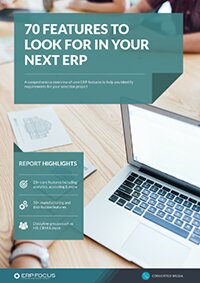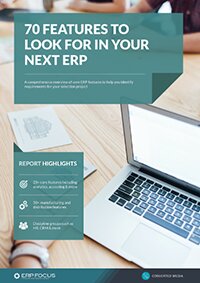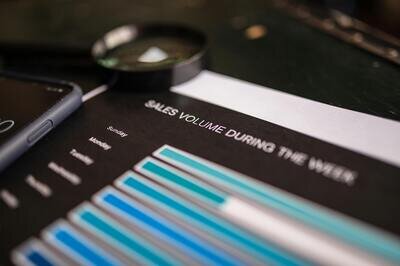ERP vs. CRM comparison
ERP and CRM are two important categories of software used by businesses and other organizations everywhere. Some still wonder which they should choose or if they should use both systems.
What is Enterprise Resource Planning?
ERP is a set of unified software programs intended to manage the business process of organizations. ERP has an internal perspective, that is, it looks within the business with the intention of improving performance, profitability, and productivity. ERP uses an extensive set of shared databases that help minimize data redundancy. ERP modules include financial management, production management, materials management, purchasing management, quality management, engineering, production scheduling, human resources management, payroll, business intelligence, and general systems management of the ERP system. Usually, modules are chosen as options by users depending on the needs of that business. ERP, with the wide choices of available modules, is often used to some extent by a range of people throughout a business across all departments.
What is Customer Relationship Management?
CRM is software designed to capture every detail of the transactions between a company and its clients, customers, and prospects. CRM looks externally at contacts and businesses that are or could be customers. CRM stores and manages customer and prospect data. Where most departments use ERP, people in sales and marketing departments primarily use CRM. Customers will be included along with contact details for those customers. Other businesses or prospects that might someday be converted to customers will be also included in the database. Every communication of any type will get a data record linked to a customer or prospect file. That communication record will also link internally to the person or category of communication within the business. CRM helps a business to identify the products and services desired, who makes a decision to purchase those products, and how that decision is made. CRM is used to track prospects as they are introduced to a business’ products and services, learn more about them, and help them eventually decide to purchase from your business rather than a competitor.
What software do you need: ERP of CRM?
Your needs could be either ERP or CRM. You might also need both ERP and CRM. Examine your business needs carefully and get a consensus of agreement from your functional leaders as well as from your executive management. Check with people from various levels within your organization, as users probably see things differently from management. Where are the pain points? Where is the handoff from one person to the next difficult? Where are mistakes and errors common? When should there be systematic guidance in making the optimal choice for the good of the entire enterprise?
Use our free requirements guide to gather your needs for ERP in one place
List your requirements by priority with those that must be addressed first. Quantify the needs – how much does each need cost today in terms of money and lost productivity?
Your own business priorities might be weighted heavily toward requirements that can only be satisfied by ERP. The need for CRM could exist but be at a lower priority level which indicates CRM is not a system to be considered – yet.
Many ERP systems include a CRM module. Those ERP modules might include enough features to satisfy your needs. Some of your needs might only be satisfied through the acquisition of a complete CRM system.
After evaluating ERP and CRM, you can estimate the cost of implementing and maintaining the systems and begin an evaluation of the return on your investment to determine if that return is sufficient to pass your business’ threshold.
What do ERP and CRM have in common?
Both of these systems are business-oriented and use databases. Both intend to increase the business’ profit. ERP software has been in use longer, whereas CRM is newer software. CRM began as stand-alone systems and most commonly today, it still is a separate system. Many ERP systems today now offer a CRM module that includes many of the most-used features of a stand-alone CRM. When we use CRM within ERP as a module, we continue using shared databases that now include tables intended for CRM.
Why would you need ERP?
Start with A as in accounting. All businesses need to report financial data and all ERP systems provide a financial module. Finance is at the core of many ERP systems. ERP systems track every kind of transaction including payroll, hours worked chargeable to expense accounts or to work in process through payments for inventory and equipment. ERP provides user-friendly entry screens to simplify these transactions and uses business logic to assist with decision support in all areas of a business. In short, nearly all businesses need ERP. Not every business will use every available module within an ERP, but all but even the smallest, most simple businesses can use ERP profitably.
ERP includes inventory management, listing every item in stock along with the accounting value by item and collectively. ERP includes purchasing management. ERP algorithms help decide which items are due to be purchased and manage the incoming order from initial placement through transportation channels, through incoming quality inspections, and into inventory stores.
ERP helps manage production. Shop work is defined by jobs by ERP. Those jobs are scheduled, personnel is assigned to work on the jobs, materials are issued to the job, and when the work is complete, the job moves as finished products into inventory and to a customer as a shipment.
ERP includes business intelligence tools that allow a business to define and publish dashboards and reports to better manage the work. Business intelligence is most useful to define rules that help people anywhere in the organization make the best decisions wherever they are to support the overall business optimization.
Why would you need CRM?
A business interested in growing sales and revenue probably wants CRM. A growing business with many developing prospects that need nurturing over time until they develop into paying customers will want CRM. CRM is an important component of a business’ marketing efforts. It will help manage marketing and sales collateral. CRM analyses will monitor which products sell best as well as who buys those products and when they make those purchase decisions.
CRM helps manage the pipeline where prospects indicate more and more interest over time, eventually becoming customers. CRM helps a business track and manage the time required to convert a prospect into a customer. CRM tracks every customer interaction including mail, phone calls, contacts at trade shows, and replies to various marketing efforts. CRM also includes every person as a contact related to a customer business so that approval cycles can be managed and there is knowledge of who is required to approve any type of purchase. CRM allows a business to share the same customer profile among all functions so that all can know a single perspective toward that customer. Those customer views can be filtered, as needed, to protect certain data.
ERP and CRM integration
Integration of ERP and CRM systems is certainly possible. ERP systems typically have many tables with relatively few fields. These tables are somewhat normalized after years of use. CRM tables are fewer and often have many more columns of data as compared to ERP tables. Many of the fields in CRM tables contain unstructured text and documents which cannot easily be linked to other tables. That said, plenty of ERP and CRM systems have already been integrated and there are experienced developers ready to help. Salesforce is the one of the most popular CRMs today and some ERP developers, recognizing this, have begun selling their systems with hooks specifically for Salesforce built in.
Use this free ERP features guide to determine what functionality you need from your system
Integration of ERP and CRM requires bi-directional data flow. Often new customer orders are created in CRM and then must flow to ERP for production, supply chain, and fulfillment processes. Promise dates and shipment dates begin in ERP and must flow to CRM as that is the database used to communicate with customers.
Customer records of all kinds will exist in both ERP and CRM. We want as little redundant data as possible so a choice whether to use the ERP or CRM customer record is required. This is not an easy choice. We could choose to use the CRM customer master file and the ship-to customer address subfile within ERP. Now here is another set of links to be integrated. We need to remember that constraints and regulations, such as GDPR, exist. Where there is a possibility that certain customer data must be protected, we want to keep that data as segregated as we can so that the data can be properly managed and controlled.
If your choice is to use CRM as a module within ERP, the integration is already done for you by the developers. Both systems will use a single customer master data set. Customer ship-to address records will be used by ERP and ignored by CRM.
So, which should you choose?
The choice is yours to make and there is no easy, one-size-fits-all answer. Your unique requirements must be met. If those requirements dictate a CRM, you will need that software. If your requirements also dictate an ERP system, you need that software as well. If your resources limit your choices, you can consider CRM within ERP that ought to meet many of your requirements. Gather the troops and put on your thinking caps. Make the choice that best fits your business.
Free white paper

70 features to look for in your next ERP
A comprehensive guide to help you identify requirements for your ERP selection

Featured white papers
-

70 features to look for in your next ERP
A comprehensive guide to help you identify requirements for your ERP selection
Download
Related articles
-

Top benefits of ERP inventory management
How an ERP helps inventory management including four key advatages
-

Secret KPI: Why Your ERP Implementation Team Matters More Than Software
Learn how Godlan ensures successful ERP implementation for manufacturers with proven strategies &...
-

How to use ERP project management tools to improve efficiency
Advice on using your ERP project management tools to their full potential

